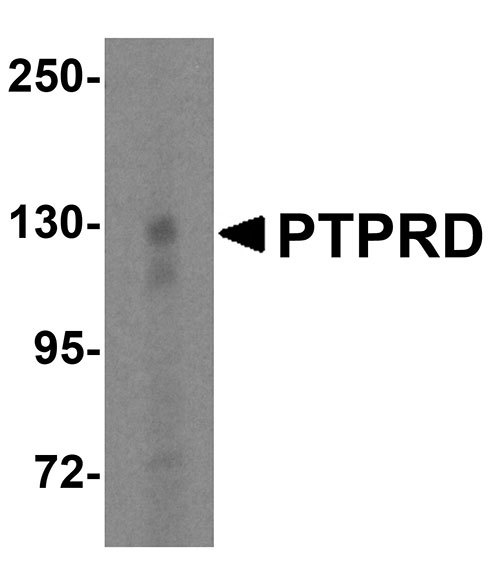PTPRD Antibody
- 产品详情
- 实验流程
- 背景知识
Application
| WB, E |
|---|---|
| Primary Accession | P23468 |
| Other Accession | NP_569075, 289547551 |
| Reactivity | Human |
| Host | Rabbit |
| Clonality | Polyclonal |
| Isotype | IgG |
| Calculated MW | 214760 Da |
| Concentration (mg/ml) | 1 mg/mL |
| Conjugate | Unconjugated |
| Application Notes | PTPRD antibody can be used for detection of PTPRD by Western blot at 1 - 2 µg/mL. |
| Gene ID | 5789 |
|---|---|
| Other Names | Receptor-type tyrosine-protein phosphatase delta, Protein-tyrosine phosphatase delta, R-PTP-delta, 3.1.3.48, PTPRD |
| Target/Specificity | PTPRD; PTPRD antibody is human specific. At least three alternatively spliced transcript variants encoding distinct isoforms have been observed. PTPRD cleavage products are often observed in vivo |
| Reconstitution & Storage | PTPRD antibody can be stored at 4℃ for three months and -20℃, stable for up to one year. As with all antibodies care should be taken to avoid repeated freeze thaw cycles. Antibodies should not be exposed to prolonged high temperatures. |
| Precautions | PTPRD Antibody is for research use only and not for use in diagnostic or therapeutic procedures. |
| Name | PTPRD |
|---|---|
| Function | Can bidirectionally induce pre- and post-synaptic differentiation of neurons by mediating interaction with IL1RAP and IL1RAPL1 trans-synaptically. Involved in pre-synaptic differentiation through interaction with SLITRK2. |
| Cellular Location | Membrane; Single-pass type I membrane protein. |
For Research Use Only. Not For Use In Diagnostic Procedures.
Provided below are standard protocols that you may find useful for product applications.
BACKGROUND
PTPRD Antibody: PTPRD (Protein tyrosine phosphatase receptor type D) is a member of the protein tyrosine phosphatase (PTP) family that plays diverse roles during development including cell growth, differentiation, mitotic cycle and oncogenic transformation. PTPRD contains an extracellular region, a single transmembrane segment and two tandem intracytoplasmic catalytic domains. The extracellular region of PTPRD is composed of three Ig-like and eight fibronectin type III-like domains (1,3). PTPRD interacts with PPFIA1-3 and is a tumor suppressor on chromosome 9p that is involved in the development of glioblastoma multiforme (GBMs) and multiple human cancers.
REFERENCES
Krueger NX, Streuli M, and Saito H. Structural diversity and evolution of human receptor-like protein tyrosine phosphatases. EMBO J. 1990; 9:3241-52.
Fischer EH, Charbonneau H and Tonks NK. Protein tyrosine phosphatases: a diverse family of intracellular and transmembrane enzymes. Science 1991; 253:401-6.
Pan MG, Rim C, Lu KP et al. Cloning and expression of two structurally distinct receptor-linked protein-tyrosine phosphatases generated by RNA processing from a single gene. J. Biol. Chem. 1993; 268:19284-91.
Veeriah S, Brennan C, Meng S, et al. The tyrosine phosphatase PTPRD is a tumor suppressor that is frequently inactivated and mutated in glioblastoma and other human cancers. Proc. Natl. Acad. Sci. USA 2009; 106: 9435-40.
终于等到您。ABCEPTA(百远生物)抗体产品。
点击下方“我要评价 ”按钮提交您的反馈信息,您的反馈和评价是我们最宝贵的财富之一,
我们将在1-3个工作日内处理您的反馈信息。
如有疑问,联系:0512-88856768 tech-china@abcepta.com.























 癌症的基本特征包括细胞增殖、血管生成、迁移、凋亡逃避机制和细胞永生等。找到癌症发生过程中这些通路的关键标记物和对应的抗体用于检测至关重要。
癌症的基本特征包括细胞增殖、血管生成、迁移、凋亡逃避机制和细胞永生等。找到癌症发生过程中这些通路的关键标记物和对应的抗体用于检测至关重要。 为您推荐一个泛素化位点预测神器——泛素化分析工具,可以为您的蛋白的泛素化位点作出预测和评分。
为您推荐一个泛素化位点预测神器——泛素化分析工具,可以为您的蛋白的泛素化位点作出预测和评分。 细胞自噬受体图形绘图工具为你的蛋白的细胞受体结合位点作出预测和评分,识别结合到自噬通路中的蛋白是非常重要的,便于让我们理解自噬在正常生理、病理过程中的作用,如发育、细胞分化、神经退化性疾病、压力条件下、感染和癌症。
细胞自噬受体图形绘图工具为你的蛋白的细胞受体结合位点作出预测和评分,识别结合到自噬通路中的蛋白是非常重要的,便于让我们理解自噬在正常生理、病理过程中的作用,如发育、细胞分化、神经退化性疾病、压力条件下、感染和癌症。






